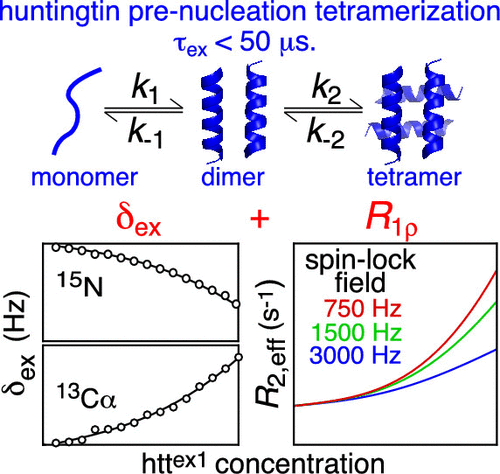当前位置:
X-MOL 学术
›
J. Phys. Chem. Lett.
›
论文详情
Our official English website, www.x-mol.net, welcomes your
feedback! (Note: you will need to create a separate account there.)
Kinetics of Fast Tetramerization of the Huntingtin Exon 1 Protein Probed by Concentration-Dependent On-Resonance R1ρ Measurements.
The Journal of Physical Chemistry Letters ( IF 4.8 ) Pub Date : 2020-06-26 , DOI: 10.1021/acs.jpclett.0c01636 Alberto Ceccon 1 , Vitali Tugarinov 1 , G Marius Clore 1
The Journal of Physical Chemistry Letters ( IF 4.8 ) Pub Date : 2020-06-26 , DOI: 10.1021/acs.jpclett.0c01636 Alberto Ceccon 1 , Vitali Tugarinov 1 , G Marius Clore 1
Affiliation

|
An approach for the quantitative description of the kinetics of very fast exchange processes (τex < 50–100 μs) associated with transient, reversible protein oligomerization, is presented. We show that on-resonance 15N-R1ρ measurements conducted as a function of protein concentration at several spin-lock radio frequency field strengths are indispensable for unambiguous determination of the rate constants for interconversion between monomeric and higher order oligomeric species. The approach is experimentally demonstrated on the study of fast, reversible tetramerization of the full-length Huntingtin exon 1 protein, httex1, responsible for Huntington’s disease. Incorporation of concentration-dependent 15N-R2,eff data, obtained from on-resonance R1ρ measurements performed at three spin-lock field strengths, into analysis of the kinetic scheme describing reversible tetramerization of httex1 allowed us to uniquely determine the rate constants of interconversion between the various species. This approach serves as a valuable complement to the existing array of NMR techniques for studying early, transient oligomerization events in protein aggregation pathways.
中文翻译:

亨廷顿外显子1蛋白快速四聚的动力学,通过浓度依赖性共振R1ρ测量来探测。
对于非常快速的交换过程的动力学的定量描述(τ的方法前<50-100微秒)短暂的,可逆的蛋白低聚相关联,提出。我们表明,在共振15 N- [R 1ρ测量在几个自旋锁射频场强作为蛋白浓度的函数进行是明确确定的速率常数的对单体和更高阶低聚物之间的相互转换是必不可少的。该方法已在负责亨廷顿氏病的全长Huntingtin外显子1蛋白htt ex1的快速,可逆四聚化研究中得到实验证明。纳入浓度依赖性15N- [R 2,EFF数据,从共振获得ř 1ρ测量在三个自旋锁定的场强进行,进动力学方案的分析说明Htt的可逆四聚EX1使我们能够唯一地确定各个之间相互转换的速率常数种类。该方法可作为现有NMR技术阵列的有价值的补充,用于研究蛋白质聚集途径中的早期,瞬时低聚事件。
更新日期:2020-07-16
中文翻译:

亨廷顿外显子1蛋白快速四聚的动力学,通过浓度依赖性共振R1ρ测量来探测。
对于非常快速的交换过程的动力学的定量描述(τ的方法前<50-100微秒)短暂的,可逆的蛋白低聚相关联,提出。我们表明,在共振15 N- [R 1ρ测量在几个自旋锁射频场强作为蛋白浓度的函数进行是明确确定的速率常数的对单体和更高阶低聚物之间的相互转换是必不可少的。该方法已在负责亨廷顿氏病的全长Huntingtin外显子1蛋白htt ex1的快速,可逆四聚化研究中得到实验证明。纳入浓度依赖性15N- [R 2,EFF数据,从共振获得ř 1ρ测量在三个自旋锁定的场强进行,进动力学方案的分析说明Htt的可逆四聚EX1使我们能够唯一地确定各个之间相互转换的速率常数种类。该方法可作为现有NMR技术阵列的有价值的补充,用于研究蛋白质聚集途径中的早期,瞬时低聚事件。











































 京公网安备 11010802027423号
京公网安备 11010802027423号